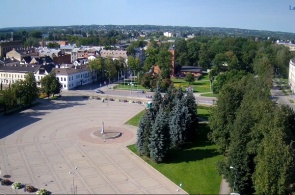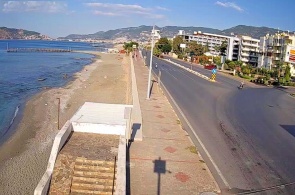Daugavpils can be safely called one of the most amazing cities in Latvia. Located in the south-east of the country, this city is a major center for education, tourism and logistics in the republic, second only to the capital, Riga. The picturesquely flowing river Western Daugava divided it into two parts. Daugavpils has a temperate continental climate, which slightly distinguishes it from the settlements located on the coast.
The history of this city began with the fact that back in 1275 the Livonian Order built the castle of Dinaburg here. For several centuries, the fortress was captured by the Lithuanians, the Poles, and the troops of Ivan the Terrible, until in the XVIII century it was finally ruled by the Russian Empire. In the XIX century, tsarist Russia turned Dinaburg into the largest populated area of the Baltic States. By decree of Emperor Alexander III, the city was named Dvinsk, but after the formation of the Republic of Latvia in 1920, it acquired the original name of Daugavpils.
This town does not have its own airport, although the authorities are actively working on the creation of an international terminal. The nearest air gate is located in the capital of Latvia. Tourists travel to Daugavpils by train from Belarus, Russia, Lithuania and other countries. Also established bus service. High-quality roads link a large Latvian center with various localities in Russia and Europe.
The historical center is perhaps the most remarkable part of the city. It is built up with buildings of the XIX-XX centuries. The fortress built at the beginning of the 19th century is considered to be the true symbol of Daugavpils. This fortification structure was intended to protect the western borders of the Russian Empire. Despite all the historical troubles, the castle in its original form has survived to the present day.
Visiting Daugavpils, it will not be superfluous to look at the Temple Hill. Here is the Cathedral of St. Luther. The brick pseudo-gothic building was erected at the end of the XIX century. A little younger than him, located nearby, the Roman Catholic Cathedral of the Blessed Virgin Mary, which combines the features of Baroque and Classicism. The largest Orthodox church in Daugavpils is the temple of Boris and Gleb, built before the start of the First World War.
In addition to these architectural structures, this marvelous city can surprise you with many interesting places that will definitely appeal to an outsider.
More details
As soon as the pet enters the shelter, he lives there as long as needed to provide the necessary medical services and looking for a new home — "do Not euthanize animals" is the most important rule for a shelter.
Daugavpils, Latvia
08.02.17
The camera is installed on the building of the hotel Latgola in Daugavpils, Latvia. The view covers an area of Unity and adjoining buildings and gardens. This is the main square of the city, located in its Central part, which began to be built in the XIX century. The square of Unity is more than 11 thousand m2. There are concerts, fairs and other cultural and social events. In the winter, in the middle of the square is established, the main city Christmas tree.
Daugavpils, Latvia
13.08.16
popular camerasshow all
Sultanahmet or Blue mosque is a work of art of Turkish-Islamic architecture. Its construction began in 1609, the construction work took seven years to a 19-year-old Sultan. The name of the mosque was, due to its interesting and unique finish.
Istanbul, Turkey
08.02.14
Stavanger, a town in the commune of Norway, located in the South-Western part of the country, on the Peninsula, rich in minerals. Tanager combines the influence of foreign organisations such as NATO and oil companies. The camera will shoot the harbour and the promenade of the city.
Stavanger, Norway
03.11.13
A webcam broadcasts the district of Tosmur - quiet location in the Eastern part of Alanya, located only five kilometres from the city centre. Its rural way of life and the beauty of untouched nature attract tourists.
Alanya, Turkey
10.11.18
Shark Island or in English of Shark island, located in the harbour city of Sydney, the suburb of Point Piper. The locals, the natives named the island Boambilly, which translated means Shark island. After all, this name is not casual, because it's mean and looks like a shark fin.
Sydney, Australia
31.10.13
The webcam is installed on site Alva. Tsaghkadzor ski resort town in Armenia. Tsaghkadzor is a beautiful mountainous area among deciduous forests, with a pleasant winter climate, and clean fresh air. The highest point is 1800 meters. The truss type is a classic, divided into three.
Tsakhkadzor, Armenia
18.01.14








